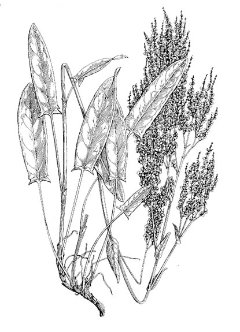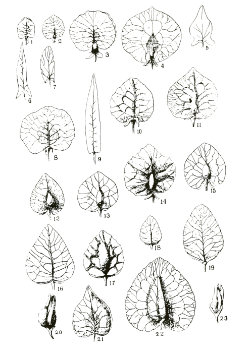 |
|
edibleplants.org |
 |
| Rumex species. edibleplants.org |
Translate this page:
Summary
Rumex papillaris is native to the Iberian Peninsula. It is closely related to other common sorrels like R. acetosa, which are widely consumed in the Mediterranean region.
Physical Characteristics

 Rumex papillaris is an evergreen Perennial growing to 0.2 m (0ft 8in) by 0.1 m (0ft 4in) at a fast rate.
Rumex papillaris is an evergreen Perennial growing to 0.2 m (0ft 8in) by 0.1 m (0ft 4in) at a fast rate.
See above for USDA hardiness. It is hardy to UK zone 7. The flowers are pollinated by Wind, Insects, Butterflies.
It is noted for attracting wildlife.
Suitable for: light (sandy), medium (loamy) and heavy (clay) soils, prefers well-drained soil and can grow in nutritionally poor soil. Suitable pH: mildly acid, neutral and basic (mildly alkaline) soils. It cannot grow in the shade. It prefers dry or moist soil and can tolerate drought.
UK Hardiness Map
US Hardiness Map
Synonyms
Homotypic Synonyms: Acetosa papillaris (Boiss. & Reut.) Holub. Acetosa pratensis subsp. papillaris (Boiss. & Reut.) Á.Löve & B.M.Kapoor. R. acetosa var. papillaris (Boiss. & Reut.) P.Fourn. R. acetosa proles papillaris (Boiss. & Reut.) Rouy. R. acetosa subsp. papillaris (Boiss. & Reut.) Franco. R. thyrsiflorus subsp. papillaris (Boiss. & Reut.) Sagredo & Malag. Heterotypic Synonyms: R.javalambrensis Pau. R. papillaris subsp. javalambrensis (Pau) G.López.
Plant Habitats
Edible Uses
A wild food plant [2-4] . Basal leaves are eaten raw or for seasoning and flavouring. The tender leaves of Rumex papillaris offer several positive dietary benefits. They have a low energy value (less than 40 kcal per 100 grams) and are a good source of dietary fibre (more than 3 grams per 100 grams). They contain a high proportion of polyunsaturated fatty acids (PUFA) and omega-3 fatty acids compared to other vegetables. Additionally, they have very low sodium content (less than 40 mg per 100 grams) and can be a good source of manganese, vitamins C and B9 (folates), and occasionally potassium. However, the leaves can have high levels of oxalates, so boiling is recommended for safe consumption by the general population. Widely used in the past and currently still in use but affected by changes in land use [2-4] .
References More on Edible Uses
Medicinal Uses
Plants For A Future can not take any responsibility for any adverse effects from the use of plants. Always seek advice from a professional before using a plant medicinally.
Antioxidan Properties
References More on Medicinal Uses
The Bookshop: Edible Plant Books
Our Latest books on Perennial Plants For Food Forests and Permaculture Gardens in paperback or digital formats.

Edible Tropical Plants
Food Forest Plants for Hotter Conditions: 250+ Plants For Tropical Food Forests & Permaculture Gardens.
More

Edible Temperate Plants
Plants for Your Food Forest: 500 Plants for Temperate Food Forests & Permaculture Gardens.
More

More Books
PFAF have eight books available in paperback and digital formats. Browse the shop for more information.
Shop Now
Other Uses
Rumex species are used as food plants by the larvae of several Lepidoptera species and are the only host plants of Lycaena rubidus.
Special Uses
References More on Other Uses
Cultivation details
This species is harvested in the wild. Mediterranean climate. Branching rhizomes. A dioecious plant.
References Carbon Farming Information and Carbon Sequestration Information
Temperature Converter
Type a value in the Celsius field to convert the value to Fahrenheit:
Fahrenheit:
The PFAF Bookshop
Plants For A Future have a number of books available in paperback and digital form. Book titles include Edible Plants, Edible Perennials, Edible Trees,Edible Shrubs, Woodland Gardening, and Temperate Food Forest Plants. Our new book is Food Forest Plants For Hotter Conditions (Tropical and Sub-Tropical).
Shop Now
Plant Propagation
Seed.
Other Names
If available other names are mentioned here
Spanish: Acedera. Spanish Sorrel. Spanish Dock.
Native Range
Native to: Portugal, Spain.
Weed Potential
Right plant wrong place. We are currently updating this section.
Please note that a plant may be invasive in one area but may not in your area so it's worth checking.
None Known
Conservation Status
IUCN Red List of Threatened Plants Status : This species has not yet been assessed for the IUCN Red List.

Growth: S = slow M = medium F = fast. Soil: L = light (sandy) M = medium H = heavy (clay). pH: A = acid N = neutral B = basic (alkaline). Shade: F = full shade S = semi-shade N = no shade. Moisture: D = dry M = Moist We = wet Wa = water.
Now available:
Food Forest Plants for Mediterranean Conditions
350+ Perennial Plants For Mediterranean and Drier Food Forests and Permaculture Gardens.
[Paperback and eBook]
This is the third in Plants For A Future's series of plant guides for food forests tailored to
specific climate zones. Following volumes on temperate and tropical ecosystems, this book focuses
on species suited to Mediterranean conditions—regions with hot, dry summers and cool, wet winters,
often facing the added challenge of climate change.
Read More
Expert comment
Author
Boiss. & Reut.
Botanical References
Links / References
For a list of references used on this page please go here
Readers comment
| Add a comment |
|
If you have important information about this plant that may help other users please add a comment or link below. Only comments or links that are felt to be directly relevant to a plant will be included. If you think a comment/link or information contained on this page is inaccurate or misleading we would welcome your feedback at [email protected]. If you have questions about a plant please use the Forum on this website as we do not have the resources to answer questions ourselves.
* Please note: the comments by website users are not necessarily those held by PFAF and may give misleading or inaccurate information.
To leave a comment please Register or login here All comments need to be approved so will not appear immediately.
|
Subject : Rumex papillaris
|
|
|
|